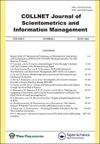Patentometric review on automated plant phenotyping
IF 0.8
Q2 INFORMATION SCIENCE & LIBRARY SCIENCE
COLLNET Journal of Scientometrics and Information Management
Pub Date : 2023-01-01
DOI:10.47974/cjsim-2022-0047
引用次数: 0
Abstract
Plant phenotyping involves the measurement of observable traits of plants. Plant traits like leaf area, leaf count, leaf surface temperature, chlorophyll content, plant growth rate, emergence time of leaves, and reproductive organs depend on the interaction of its genotype with the environment. Plant phenotyping serves to analyze biotic and abiotic stresses on plants, select crop varieties resilient to the surrounding environment, and improve crop yield. Recent advancements in imaging technologies help expedite the growth of automatic, non-invasive, and efficient plant phenotyping systems. These plant phenotyping systems involve using different imaging techniques like visible imaging, hyperspectral imaging, chlorophyll fluorescence imaging (CFIM), thermal imaging to record, monitor, and analyze plant phenotypes using images. In the last few years, researchers have been working on developing image processing, computer vision, machine learning, and deep learning approaches for the accurate and precise analysis of plant images. Therefore, this paper reviews and presents insights about the research reported through patents in the area of automatic plant phenotyping. This review report uses patent databases like Espacenet, Lens, and Google Patents to search, review and analyze patent documents. The paper presents a patentometric analysis of all 67 patent documents available till date focusing on automatic image-based plant phenotyping. The review provides a summary and analysis of outstanding patents in terms of qualitative and quantitative patent indices. This article provides a comprehensive global patent study to aid researchers and scientists develop more efficient plant phenotyping algorithms, devices, and systems.植物表型自动分型的专利计量学研究进展
植物表型包括测量植物的可观察性状。植物的叶面积、叶数、叶表面温度、叶绿素含量、植物生长速度、叶片出芽时间和生殖器官等性状取决于其基因型与环境的相互作用。植物表型分析用于分析植物的生物和非生物胁迫,选择适应周围环境的作物品种,提高作物产量。成像技术的最新进展有助于加快自动、非侵入性和高效植物表型系统的发展。这些植物表型系统涉及使用不同的成像技术,如可见光成像、高光谱成像、叶绿素荧光成像(CFIM)、热成像来记录、监测和分析植物表型。在过去的几年里,研究人员一直致力于开发图像处理、计算机视觉、机器学习和深度学习方法,以准确和精确地分析植物图像。因此,本文对植物自动表型领域的专利研究进行了综述并提出了一些见解。本审查报告使用专利数据库,如Espacenet、Lens和谷歌Patents来搜索、审查和分析专利文件。本文介绍了迄今为止所有67个专利文件的专利计量分析,重点是基于自动图像的植物表型。本文从定性和定量两方面对我国优秀专利进行了总结和分析。本文提供了一项全面的全球专利研究,以帮助研究人员和科学家开发更有效的植物表型算法、设备和系统。
本文章由计算机程序翻译,如有差异,请以英文原文为准。
求助全文
约1分钟内获得全文
求助全文
来源期刊

COLLNET Journal of Scientometrics and Information Management
INFORMATION SCIENCE & LIBRARY SCIENCE-
自引率
0.00%
发文量
11
 求助内容:
求助内容: 应助结果提醒方式:
应助结果提醒方式:


